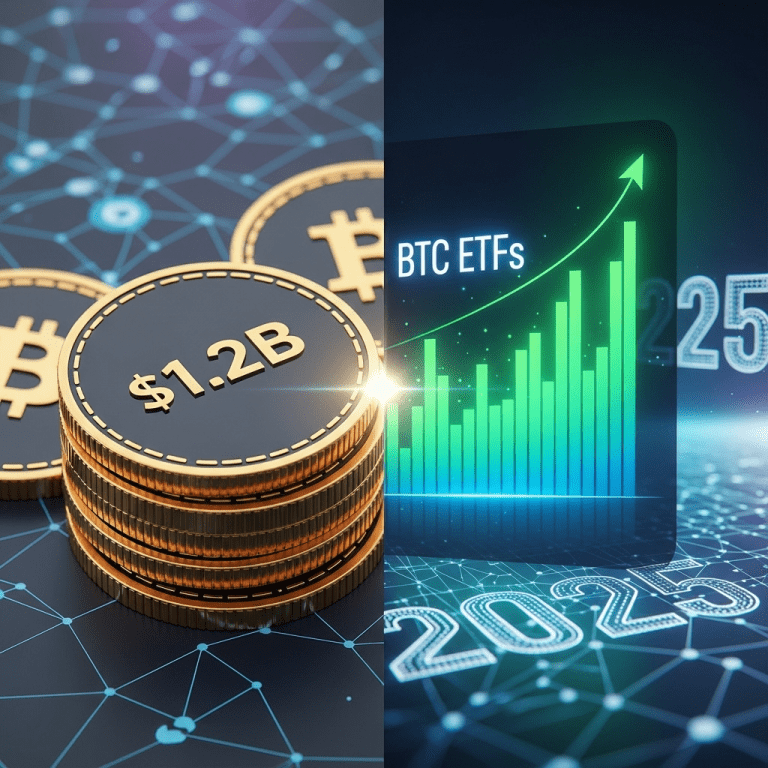In a whirlwind week for the crypto markets, Bitcoin firms bought $1.2B last week, but BTC ETFs stole the show, signaling a transformative moment in digital asset investing. As institutions and retail investors alike continue to seek exposure to Bitcoin, the competitive performance between spot purchases by Bitcoin-focused firms and record inflows into exchange-traded funds (ETFs) underscores evolving strategies and shifting market dominance in 2025.
Why Bitcoin Firms Bought $1.2B Last Week, But BTC ETFs Stole the Show
The headline statistic—Bitcoin firms bought $1.2B last week, but BTC ETFs stole the show—offers a snapshot of the current crypto zeitgeist. While direct investments by established Bitcoin companies signal continued bullishness on the asset’s long-term trajectory, the unprecedented interest and net inflows into newly launched and existing Bitcoin ETFs have fundamentally altered how investors access and perceive Bitcoin exposure.
Record Institutional Demand Spurs Bitcoin Firms’ Buying Spree
Traditional Bitcoin-heavy firms, including major mining operations, asset managers, and fintech innovators, collectively allocated over $1.2 billion to Bitcoin in a single week. This surge stemmed largely from confidence in the broader macroeconomic outlook: ongoing inflation concerns, increased regulatory clarity, and anticipation of the next Bitcoin halving cycle have all contributed to a robust institutional appetite. Many industry analysts believe these large purchases are part of strategic treasury management, as firms seek to diversify assets while preparing for higher volatility and potential price appreciation in the medium and long term.
The Role of Macro Trends and Regulatory Climate
Macroeconomic signals—such as persistently high inflation and shifting monetary policies—have directly impacted how Bitcoin is perceived as a store of value. At the same time, clearer regulations across North America, the European Union, and select Asian markets have reduced perceived risks of direct Bitcoin holdings for corporations and funds. Firms are capitalizing while prices are strategically attractive, and they’re leveraging advanced custody solutions to safeguard their assets.
How BTC ETFs Stole the Spotlight
Despite the eye-catching $1.2 billion flow from Bitcoin firms, spot Bitcoin ETFs became the true stars of the week. Several leading ETFs broke records in terms of both trading volume and net inflows, eclipsing the direct allocation activity by traditional crypto firms. This surge in demand for Bitcoin ETFs can be attributed to several converging factors:
- Accessibility: For both retail and institutional investors, ETFs offer an easy on-ramp to Bitcoin exposure, bypassing the technical hurdles and risks of direct custody.
- Regulatory Stamp of Approval: The successful regulatory green-lighting of spot Bitcoin ETFs in major markets provides a new level of credibility for Bitcoin as an asset class.
- Portfolio Diversification: ETFs allow investors to seamlessly include Bitcoin alongside traditional stocks and bonds, further mainstreaming crypto assets.
Performance Metrics: ETFs vs. Direct Holdings
The comparative performance is fueling investor enthusiasm. Some Bitcoin ETFs are tracking price action with minimal tracking error, moving almost in lockstep with spot BTC. Meanwhile, the liquidity and tax efficiency offered by ETFs continue to attract high-net-worth individuals and institutional pools alike. Analysts at financial portals such as ThinkInvest have remarked on the growing “ETF premium” as capital rotation shifts from direct coin purchases to fund inflows.
Implications for Crypto Market Structure
The split between Bitcoin firms’ aggressive purchasing and ETF-dominated inflows illustrates two parallel but interconnected market drivers. Direct BTC buying by companies cements Bitcoin as a critical treasury asset in the growing digital economy. Meanwhile, the ETF surge is democratizing Bitcoin participation, inviting trillions of dollars of potential capital from conservative investors who were previously on the sidelines.
Liquidity, Volatility, and the Investor Profile
With ETFs capturing headlines and volume, daily liquidity in crypto markets has increased, and bid-ask spreads have narrowed—benefiting all participants. There are also notable shifts in investor profiles. ETFs are particularly attractive for retirement accounts and regulated funds required to adhere to strict compliance frameworks. In contrast, direct holdings continue to appeal to those seeking maximal sovereignty and hands-on security solutions.
Navigating Opportunities and Risks in 2025
For investors navigating these new dynamics, understanding the trade-offs of each investment route is crucial. ETFs offer convenience and regulatory safeguards, but may carry management fees and lack certain features such as staking. Direct Bitcoin holdings provide full asset control and participation in future blockchain upgrades, but are subject to increased custodial responsibilities.
Sources like ThinkInvest recommend a blended strategy for diversified portfolios, leveraging both institutional-grade ETFs and secure direct ownership options based on specific risk tolerance and investment goals.
Looking Forward: What the Battle for Bitcoin Exposure Reveals
The narrative that Bitcoin firms bought $1.2B last week, but BTC ETFs stole the show is emblematic of Bitcoin’s evolution in the eyes of global markets. As advancements in tech infrastructure, regulatory acceptance, and financial product innovation accelerate, the boundaries between traditional finance and digital assets will continue to blur.
Regulators and investors will closely watch whether ETF inflows can sustain their pace throughout 2025. Meanwhile, direct institutional purchases will be a key barometer for corporate adoption and strategic sentiment. Tracking these flows can be critical for anyone shaping a next-gen Bitcoin portfolio.
Stay updated on the latest trends and analysis at ThinkInvest for more insights into how Bitcoin is reshaping the global financial system.









